
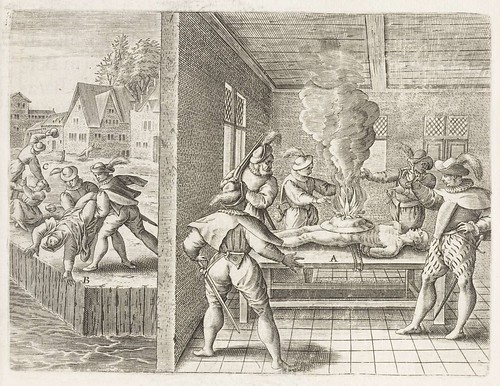


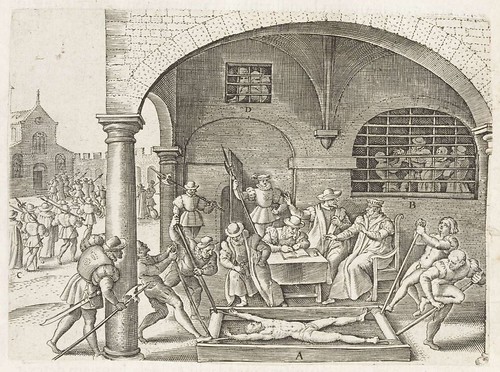
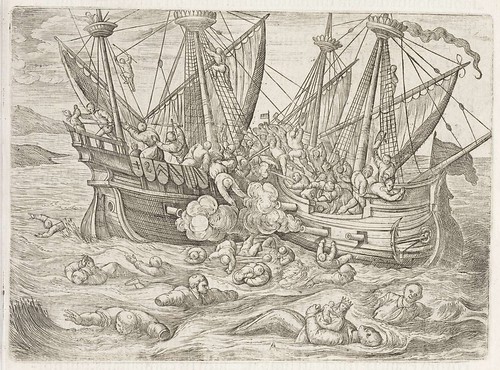

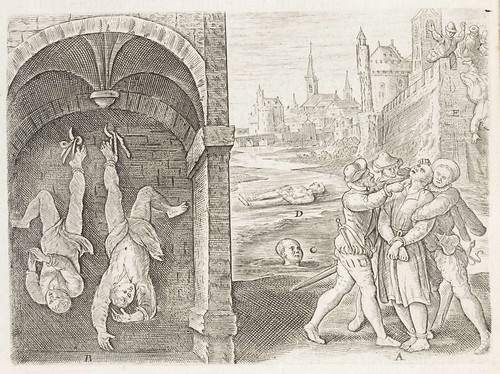
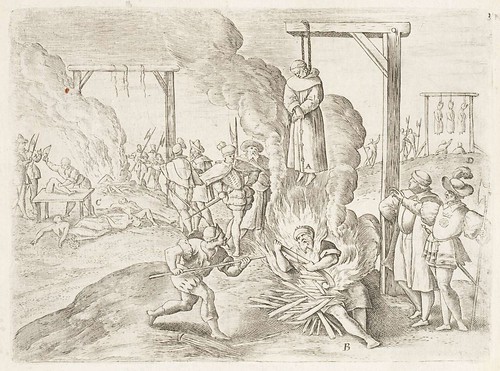
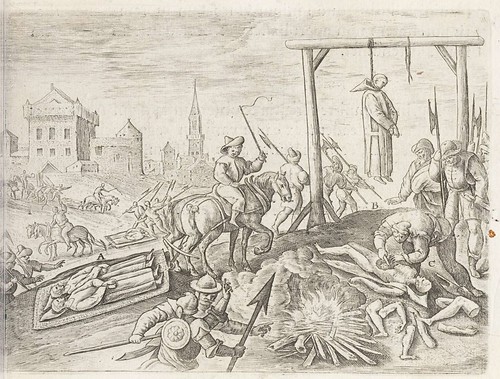
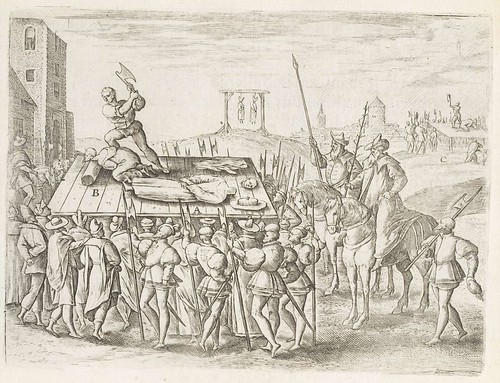
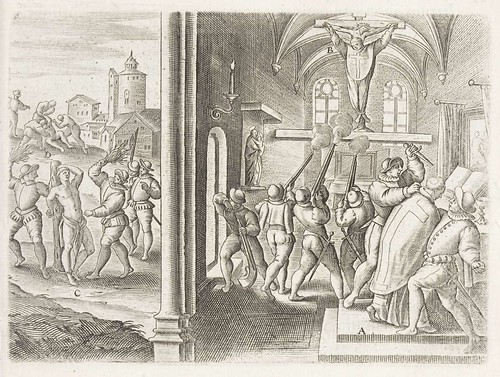
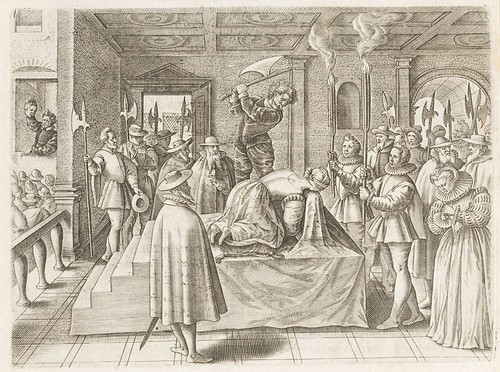
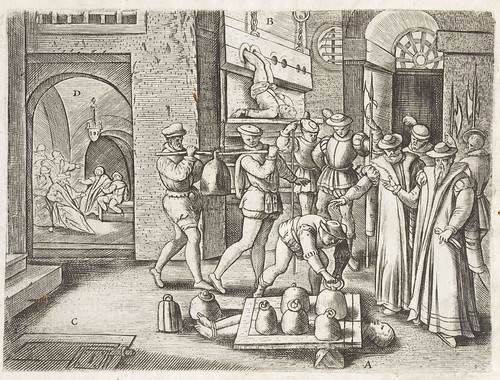
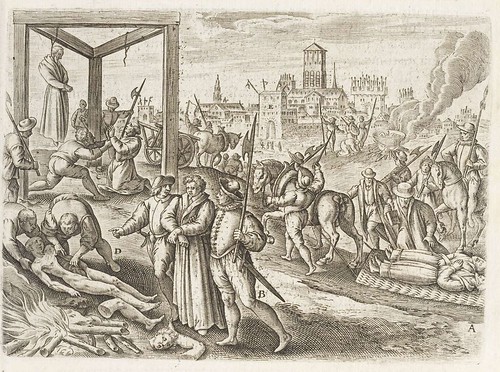
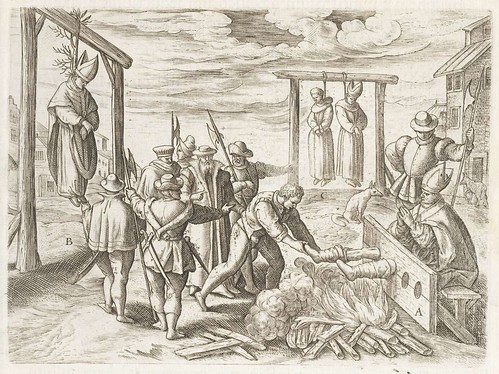
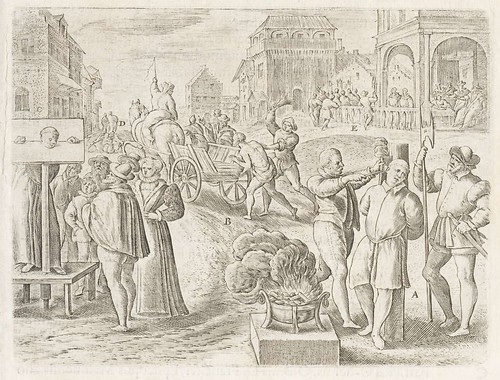
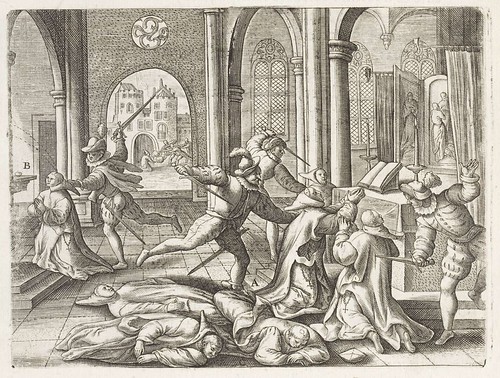
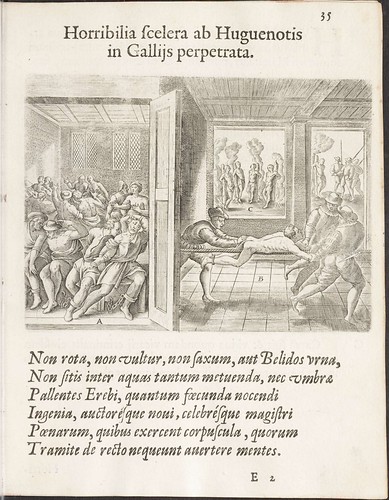
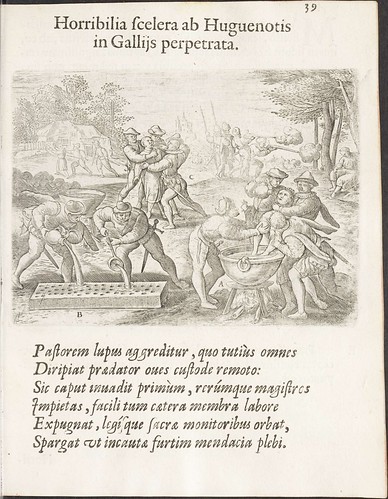
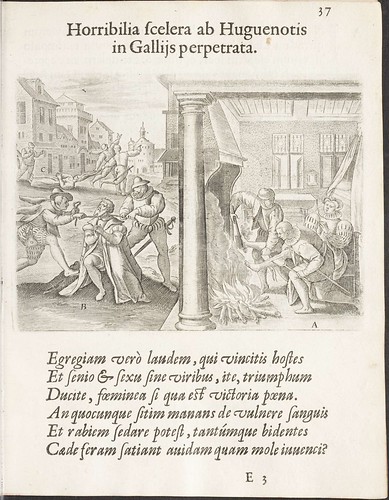
Richard Verstegan (aka Richard Rowlands) (?1548-?1636) was a Catholic Anglo-Dutch antiquarian, goldsmith and book publisher. The first half of his life was spent in England, but his religion prevented him from obtaining a degree from Oxford University, where he is thought to have studied English history and the Anglo-Saxon language.
Either following from the prejudice he suffered at Oxford or as a response to the incarceration and treatment of Mary Queen of Scots* (her 1587 beheading is seen above), Verstegan published the first edition of his martyrologium, 'Theatrum Crudelitatum', in 1583. The book may also have been conceived as a Catholic version of the famous Protestant 'Book of Martyrs' [published in 1563 as 'Actes and Monuments'] by John Foxe.
Verstegan's book attempted to record, in gruesome detail, the cruelty, torture and murder of Catholic martyrs in Europe - including English victims under the reigns of Mary I and Elizabeth I* - at the hands of Protestant heretics. Upon publication, the author was arrested and imprisoned for libel against the Crown and all books were confiscated and destroyed (a single page has been saved). Through the intervention of friends in the clerical hierarchy, Verstegan was able to secure his release and he fled the country, ultimately settling in Antwerp.
Verstegan became a very prolific and influential author and publisher in his adopted city. One of his early works was the expanded and definitive version of 'Theatrum Crudelitatum' which was published in Latin in 1587. At least some of the engravings were produced by the author (artistic training having been acquired through his goldsmith apprenticeship). It proved to be a popular book and translated editions were released soon after for the various European markets.
Although his publishing house concentrated on the production of Catholic devotional literature, Verstegan himself was known to have worked as an intelligence agent for Roman, English and Jesuit Catholics and he penned political and satirical articles for a newspaper (making him one of the earliest known journalists), all the while operating as a book and people smuggler during the Reformation*. A question mark apparently remains over a lot of works, in terms of attribution, both because Verstegan's publishing output often lacked identification marks and also because his son, with the same name, became increasingly involved in the firm's productions.
The chapter titles from the book (seen as title tags on mouseover of the unordered images above) that are included at the top of each illustrated page [the last three images above show the layout for all illustrated pages] are:
-- Persecutiones adversus Catholicos à Protestantibus Caluinistis excitae in Anglia
-- Horribilia scelera ab Hugenotis in Gallijs perpetrata
-- Horrenda inhumanitatis genera à Geusijs Belgicis peracta
-- Schismaticorum in Anglia crudelitas
- 'Theatrum Crudelitatum Haereticorum Nostri Temporis' {The theatre of cruelty of the heretics of our time} by Richard Verstegan, 1587, is hosted online by HAB Wolfenbüttel. [Most, if not all, the images were saved in this set; the majority are seen above] {Amazon}
- Richard Verstegan: New Advent / Wikipedia. There are more citations around, but they tend to be fairly specialised academic articles and the like.



















8 comments :
just found your blog...thank-you
Am I the only one who finds it incongruous that such brutal savagery is recorded with such meticulous, delicate images? This is the kind of subject matter that cries out for the distress of Goya's Horrors of War or the splatters of the painter Francis Bacon. The calm patience of this artist is highly unnerving.
My guess is there are at least two, perhaps more, artists involved. And I don't know if I'd use the word 'meticulous' to describe them other than in terms of journalistic intentions. To be honest, I was in two minds about whether to post these: when I saw the first few I wasn't overly impressed with the engraving quality although they are variable (hence I thought more than one artist was responsible).
It was only when I had seen them all that I realised it was more of an important document because of the total corpus of illustrations rather than because of the artistic value.
But yeah, unnerving is about right; again, I think that's because it records abominations without the emotion - journalism, not art. (As to whether or not it is, in fact, accurate as pictorial journalism is another question entirely).
Imagery of torture and martyrdom from past centuries often seems to be unemotional, or at least looks that way to us. Callot's famous print of mass execution included, although it distances the viewer in a way that this artist(s) doesn't.
I can't recall ever having seen anything before that turned a disemboweled person into a horse's feeding trough. Very peculiar and implausible.
It gives me a great idea for a New Year's Party punchbowl.
As an artist, I can tell you that meticulousness is the hallmark of the ReallyPissedOff. The man was on a mission, and needed to communicate his rage in a manner that would be taken seriously.
Many folks active during the Reformation also thought themselves to be important instruments of God at a pivotal point in history. That does wonders for one's hyperfocus.
MonkeyFist, if you're envisioning the punchbowl I think, wouldn't Halloween or Day of the Dead be the most suitable (other than having just gone by)?
This is great stuff! Was Verstegan from the Low Countries? Dutch names commonly shorten "van der" to "ver" as in "Van Der Straete > Verstraete", "Van Der Linde > Verlinde". It would be very interesting if he was (the time is certainly right).
At the end of the post above are links to biographical material. Certainly his family was from Holland. It's too far back in time to remember if I saw anything about 'van der' or 'ver' in passing.
Post a Comment
Comments are all moderated so don't waste your time spamming: they will never show up.
If you include ANY links that aren't pertinent to the blog post or discussion they will be deleted and a rash will break out in your underwear.
Also: please play the ball and not the person.
Note: only a member of this blog may post a comment.